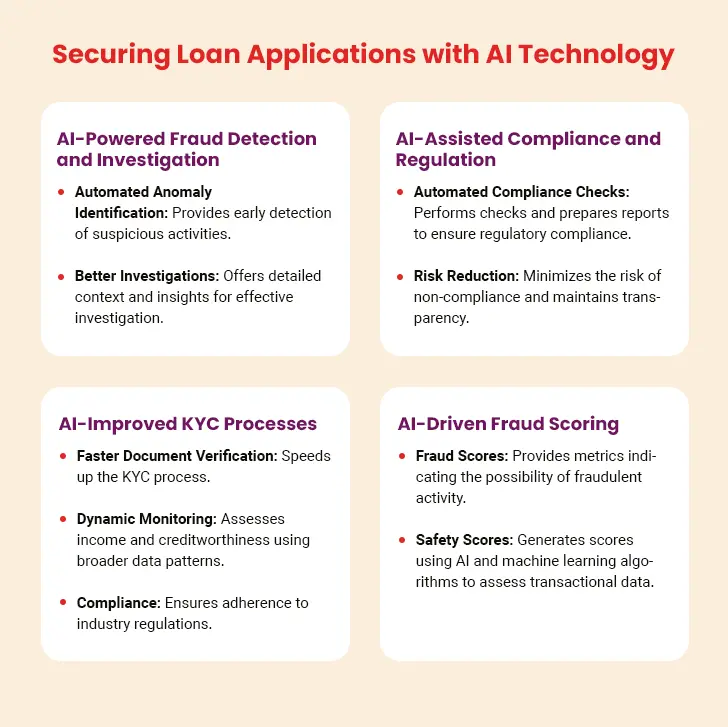Are traditional loan processing systems slowing you down? These systems often suffer from inaccuracies, slow processing times, and may fail to comply with evolving regulatory requirements.
Lending can be a complex process, and companies are always seeking to make it easier. What if approving a loan were as simple as a few clicks on your system? No more paperwork or delays. Sounds efficient, right?
Automation is making this vision a reality! It has geared up to take over tasks such as loan origination, servicing, and collections and make things easy for lenders and borrowers.
AI integration into lending helps financial institutions optimize workflows, minimize errors and improve customer experiences. Modern loan servicing software automates collections while combating loan application frauds to manage accounts efficiently.

In this detailed blog post, we will understand how AI improves collection management and mitigates default risks. We’ll also explore the common challenges that accompany AI-powered lending systems and discuss the solutions for the same. Let’s get started.
Table of Contents
How AI Improves Loan Management
Using AI to Combat Loan Application Fraud
How AI Transforms Collection Management in Lending
Ways in Which AI in Lending Mitigates Default Risks
Core AI Technologies Enabling Smarter Loan Servicing Operations
How AI Improves Loan Management
1. Streamlined Loan Approval
Loan approval used to be a lengthy process in the distant past, taking days or even weeks to complete. Huge paperwork and verification of manual data lead to prolonged qualification periods and customer dissatisfaction. Integration of AI in lending management helps with the following:
- Accurate evaluation of the creditworthiness of lenders using AI loan underwriting and predictive analytics.
- Enhanced approval workflows using machine learning. With more loans being processed, the lending management system becomes more accurate and efficient.
- Improved customer experiences using virtual assistants and chatbots that offer instant updates. These smart tools resolve common queries, freeing human agents for more complex tasks.
2. AI-Driven Credit Scoring
Before the advent of AI, credit scoring used to be a rigid process. Traditional approaches were based on existing debts, repayment history, and credit history duration. These metrics often failed to capture the overall potential and financial behavior of borrowers such as diverse payment histories and non-traditional income sources.
Now, with AI in the mix, credit scoring has changed significantly and allows for:
- Analysis of multiple data points, including factors like spending patterns and debt-to-income ratios.
- Faster formation of credit decisions, with vast datasets being analyzed within minutes.
- Increased accuracy in predicting borrower reliability and reduced possibility of false approvals.
- A comprehensive borrower view that includes alternative data sources like utility payments, rent, and spending patterns in saving and checking accounts.
3. Tailored Communication Strategies
Debt collection often poses the challenge of balancing positive customer relationships and ensuring timely payments. AI integration in loan servicing software promotes tailored communication strategies by analyzing the profiles of borrowers and customizing interactions accordingly. This helps boost engagement and improves recovery success rates.
For example, AI helps segment borrowers based on their current financial status, payment history, and communication preferences. Borrowers who have responded well to email reminders in the past might continue receiving online communication. Those who like human interactions might be directed to live agents.
AI can also tailor the tone and timing of communication. While some borrowers might prefer a friendly approach, others might appreciate a more formal communication style. Tailored strategies build an effective debt collection process and increase the probability of repayment.
Empowering Small Businesses: The Role of Loan Management Software in Microfinance
Using AI to Combat Loan Application Fraud
Financial scams are becoming increasingly complex. AI integration in loan servicing software helps tackle phishing attacks. According to the Federal Trade Commission (FTC), consumers lost more than $12.5 billion to fraud in 2024.
Let’s understand how AI in lending helps ensure a secure lending environment for lenders and borrowers.

I. AI-Powered Fraud Detection and Investigation
AI plays an important role in fraud detection by automating the earlier stages of anomaly identification and empowering investigations into suspicious activities.
Imagine a lending institution that handles large volumes of loan applications on a regular basis. In case of any warning signs such as numerous applications using the same identity, AI alerts investigators and offers them detailed context and insights to promote an effective investigation process.
II. AI-Improved KYC Processes
During the KYC process, lenders generally verify the credit history, identity, and income of the applicant via manual checks. AI helps lenders fasten document verification and monitor transactions dynamically.
It also assesses income and creditworthiness more precisely by using broader data patterns. This AI-driven improvement enables a loan servicing platform to onboard customers swiftly and make informed lending decisions.
III. AI-Assisted Compliance and Regulation
Compliance and regulation form the backbone of the lending business. AI performs automated compliance checks and prepares reports required to ascertain compliance with all the regulatory norms. This reduces the risk of non-compliance to the bare minimum and ensures transparency.
Integration with AI also enables lenders to keep pace with changing regulations and modify their processes according to the changes. This paves the way for a compliant and secure loan servicing platform.
IV. AI-Driven Fraud Scoring
Fraud scores are metrics that determine the possibility of fraudulent activity in loan applications. These scores are generated using AI and machine learning algorithms that assess transactional data to identify anomalies and patterns that indicate fraud. Each transaction is given a ‘safety score’.
Imagine a borrower who generally applies for loans with standard repayment terms and moderate credit limits. If this borrower suddenly submits numerous applications for significantly higher loan amounts with shorter repayment periods, AI-powered loan servicing software would flag this unusual activity. This will allow banks to investigate and verify the legitimacy of these loan requests quickly.
How AI Transforms Collection Management in Lending
Managing collections used to be a time-consuming and complex task in the past. Collection teams had to put in huge effort to identify and prioritize overdue accounts. This process was generally slow and required a lot of manpower.
With the implementation of AI technology, the data collection process has become significantly robust. This has led to:
- Quick identification of overdue accounts based on the debt size, overdue duration, and historical repayment patterns. This prioritizes accounts most likely to default and addresses them promptly.
- Historical data analysis to identify the most effective recovery strategies and promote the development of data-driven collection approaches.
- Use of real-time analytics to monitor response times, successful recovery rates, and customer feedback to improve productivity.
- Adoption of customer-friendly and more empathetic collection methods. Lenders can now send personalized messages that offer flexible payment options instead of generic reminders.
The Ultimate Guide to Choosing the Right Next-Gen Loan Management Software
Ways in Which AI in Lending Mitigates Default Risks
Mitigating default risks in lending is important to ensure the growth and sustainability of lending institutions. AI implementation in loan servicing software helps mitigate default risks in the following ways:
1. Effective Data Handling
Manual data handling is prone to errors and compromises the accuracy of credit scoring and loan approval. By automating the loan management process, AI helps manage huge data sets and reduces the risk of errors.
AI systems extract crucial information from digital documents, such as a borrower’s reported income, and validate it against tax records of employment data. This improves lending decisions and minimizes the likelihood of approving loans to high-risk individuals. Also, AI improves data credibility by guaranteeing that data utilized in decision-making is reliable and precise.
Audit trails generated by AI systems present a clear trail of all activities undertaken in loan approval. This allows for monitoring and accountability. This transparency promotes trust with borrowers and regulators to ensure fairness and compliance in lending.
2. Predictive Analytics
AI in loan management utilizes complex algorithms to forecast trends and outcomes. It analyses past data to help a lending management system make accurate predictions about loan approvals and credit risk. For instance, if a borrower starts exhibiting signs of financial stress, such as rising debt levels or missed payments, AI can predict the default risk.
3. Automated Decision-Making
AI algorithms can assess creditworthiness using predefined criteria, such as current income, employment history, and credit history. This removes potential bias and subjectivity from the decision-making process and leads to greater accuracy and consistency.
4. Continuous Learning
AI evolves continuously. With the introduction of new data, AI systems keep getting smarter and more accurate in their analyses and predictions. By learning from economic indicators and repayment histories, the models improve their ability to predict the likelihood of default.
5. Risk Management
AI models analyze employment and income data to detect potential red flags and risks that human analysts might overlook. This capability helps AI-powered loan servicing software make reliable decisions that align with customer needs and an organization’s risk appetite.
AI acts as a time-saver in the lending process and efficiently performs complex tasks in seconds that previously took much longer. The transition from manual processes to automated decisions depicts the impact of AI in improving customer experience and optimizing lending operations.
LoansNeo, a dependable loan servicing software for private lenders, can help financial institutions streamline diverse aspects of lending. With features such as built-in approvals and intelligent reporting, the software ensures transparency, mitigates default risk, and promotes stronger relationships between borrowers and lenders.
Core AI Technologies Enabling Smarter Loan Servicing Operations
AI technologies in lending management systems are significantly boosting loan servicing operations, making them more accurate, and customer friendly. Here are some of the key AI technologies driving these improvements:
I. Robotic Process Automation (RPA)
RPA is a form of business process automation based on AI agents or software robots. It improves loan servicing processes by handling tasks like document processing, payment verification, and compliance & reporting.
II. Computer Vision
Computer vision is employed to scrape and analyze data from documents and images. Loan servicing software employs computer vision to automate the extraction of information from loan applications, ID documents, and other documentation. This makes loan management more accurate and efficient.
III. Virtual Assistance
AI-driven virtual assistants oversee regular communication processes, send reminder messages, and gather information systematically. They offer customized counsel and support to borrowers to improve customer satisfaction.
IV. Machine Learning (ML)
ML models in loan servicing software run across large datasets to identify patterns and trends. This enables lenders to predict borrower behavior more accurately. The capability aids in risk analysis and allows for preemptive action to prevent defaults.
V. Natural Language Processing (NLP)
NLP powers virtual assistants and chatbots to understand and process customer queries. The devices can perform routine communication functions, personalize interactions based on borrower data, and boost customer experience.
Challenges and Solutions of AI in Modern Lending Management
AI is making strides in modernizing the lending industry and improving customer experience. Nevertheless, its integration into modern lending management is not without its challenges. Here are the common challenges and solutions in AI-driven lending:
| Heading | Challenge | Solution |
|---|---|---|
| Bias and Fairness | AI models can inherit biases from historical data. This can lead to unfair lending decisions. | Regularly audit AI models for bias. Use diverse training datasets and implement explainable AI (XAI) techniques to ensure fairness. |
| Regulatory Compliance | AI-driven lending must comply with strict financial regulations that require transparency and fairness. | Develop AI models with built-in explainability. Maintain compliance logs and collaborate with regulators to ensure adherence to laws. |
| Data Privacy & Security | AI requires vast amounts of financial and personal data. This increases the risk of breaches and misuse. | Implement advanced encryption, access controls, and data anonymization techniques to protect borrower information. |
| Model Interpretability | Many AI lending models operate as “black boxes”. This makes it difficult to justify decisions to regulators and customers. | Implement interpretable ML models, such as decision trees, to enable transparent loan decisions. |
| Excessive Dependence on AI | Over-reliance on AI without human oversight can lead to errors and ethical concerns. | Maintain human-in-the-loop decision-making, where AI assists but final approval involves human judgment. |
| Limited Data Availability | New borrowers or those without a credit history may not have enough data for AI to assess their creditworthiness. | Use alternative data sources such as utility payments and rental history to improve lending assessments. |
| Adaptability to Market Changes | AI models should constantly evolve with changing economic realities, regulatory updates, and fraud methods. | Train AI models regularly and use real-time monitoring of data to update models. |
| Ethical Issues | AI-based lending choices can perpetuate financial exclusion and economic inequality. | Adopt ethical AI practices, perform fairness tests, and include diverse representation in model development teams. |
| Fraud and Adversarial Attacks | Fraudsters may attempt to manipulate AI models by feeding them misleading or adversarial data. | Use anomaly detection, blockchain-based identity verification, and multi-factor authentication to prevent fraud. |
| Integration with Legacy Systems | Many financial institutions use outdated IT systems, making AI adoption difficult. | Develop API-based AI solutions that can integrate with existing banking infrastructure without requiring a complete overhaul. |
Conclusion
In the world of finance, AI is seen both as a catalyst of change and a subject of scrutiny. There’s no doubt about the tremendous potential offered by this technology in modernizing loan servicing software. However, lending institutions must also take note of the several challenges that accompany AI implementation.
The speed, accuracy, and efficiency offered by AI can take lending management to a new level and help lenders meet the pressing needs of individual borrowers with ease. By overcoming the key challenges of AI-powered loan management systems, financial institutions can ensure a balanced and responsible approach to lending.





